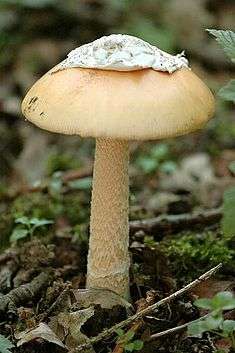Virotoxins
Virotoxins are monocyclic peptides formed by at least five different compounds: alaviroidin, viroisin, deoxoviroisin, viroidin, and deoxoviroidin.[1] The structure and biological activity of virotoxins are similar to that of phallotoxins, thus suggesting that virotoxins are biosynthetically derived from phallotoxins or share common precursor pathways.[2][3] As with phallotoxins, virotoxins are not considered to have significant toxic effects after oral exposure. At the molecular level, like phallotoxins, they interact with actin, stabilizing the bonds between actin monomers and preventing microfilaments depolymerization. However, the ultraviolet-spectra of interaction between actin and virotoxins is different from that of actin-phallotoxins, suggesting a different molecular interaction.[4] Virotoxins have a more flexible structure when compared with phallotoxins and the presence of two additional hydroxyl groups may provide different reactivity.[5][6] The intraperitoneal LD50 of virotoxins in mice ranges from 1.0 to 5.1 mg/kg and their main toxicological feature is hemorrhagic hepatic necrosis caused by an interaction of the virotoxins with outer surface of the hepatocyte through unknown mechanisms.[7] At this point, the role of virotoxins in human toxicity remains unclear, although due to its poor oral absorption, little clinical importance is given to this class of toxins.
References
- Vetter, János (January 1998). "Toxins of Amanita phalloides". Toxicon. 36 (1): 13–24. doi:10.1016/S0041-0101(97)00074-3. PMID 9604278.
- Michael J. Derelanko, ed. (2002). Handbook of toxicology (2. ed.). Boca Raton [u.a.]: CRC Press. ISBN 9780849303708.
- Brossi, Arnold, ed. (1991). The Alkaloids, 40. Burlington: Elsevier. ISBN 9780080865645.
- Turcotte, A; Gicquaud, C; Gendreau, M; St-Pierre, S (December 1984). "[Separation of the virotoxins of the mushroom Amanita virosa and comparative study of their interaction on actin in vitro]". Canadian Journal of Biochemistry and Cell Biology. 62 (12): 1327–34. doi:10.1139/o84-169. PMID 6543329.
- Faulstich, H; Buku, A; Bodenmüller, H; Wieland, T (8 July 1980). "Virotoxins: actin-binding cyclic peptides of Amanita virosa mushrooms". Biochemistry. 19 (14): 3334–43. doi:10.1021/bi00555a036. PMID 6893271.
- Wong, Jack Ho (2013). "Fungal Toxins". In Kastin, Abba J. (ed.). The handbook of biologically active peptides Chapter 25-Fungal toxins (2. ed.). Amsterdam [u.a.]: Elsevier, Acad. Press. pp. 166–168. doi:10.1016/B978-0-12-385095-9.00025-7. ISBN 978-012385095-9.
- LORANGER, A (December 1985). "Toxicity of peptides of Amanita virosa mushrooms in mice". Fundamental and Applied Toxicology. 5 (6): 1144–1152. doi:10.1016/0272-0590(85)90151-4. PMID 4092876.
